About a month ago, I met with Miami collector, Dennis Scholl, at the Galleries at Moore. Excerpts from the Debra and Dennis Scholl collection are featured in In Repose at Moore, now through Mar. 14. Below is my writeup of our conversation.
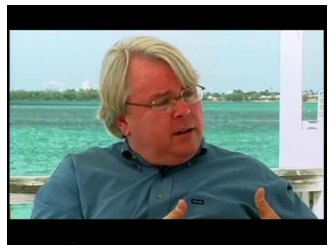
Miami art collector Dennis Scholl, talking about the Miami art scene on internet Plum TV.
I arrived at Moore College for my appointment with Miami art collector Dennis Scholl just behind a youngish-looking white-haired gentleman who went through the door and signed in at the guard’s desk. When I said my name to the guard, the man turned to me, smiled and said “Hi, I’m Dennis.”
So we walked in together got some coffee (me) and tea (him) and went into the gallery. We arrived before the staff was in and instead of waiting Scholl just took charge of the situation, grabbing two chairs and putting them side by side in the gallery for our talk. In the next hour I learned alot about the energetic Miami collector who, with his wife, Debra, have a cutting edge art collection of work by established international artists and young up and comers. Scholl sits on a number of museum boards, has been the catalyst for museum acquisition committees (Guggenheim — photography and Tate — American artists).
And — hang on — he reads Artblog (yessss!!) which he likes for our passionate commentary as well as for the fact that there’s not a lot of snarky commentary in the comments.
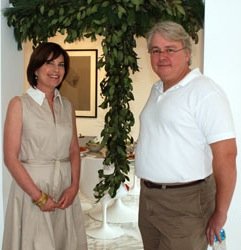
Debra and Dennis Scholl with Trisha Donnelly’s self-portrait “T” (featured in the Moore show).
Scholl opens a fat portfolio he has with him and takes out maybe 10 pounds of brochures, a book and catalogs about their collection. There are two gorgeous broadsheet catalogs, one for In Repose and one from a show in 2006 at Tulane University’s Newcomb Gallery.
Dennis: I have all this material for you. This catalog is from a show at Tulane. It was New Orleans a year after Katrina. Nobody would lend any art (because of the damp and ruinous conditions down there).
So they lent from their collection to make a show about loss and renewal, power and powerlessness. Paul Chan, Paul Pfeiffer, Christian Marclay, Hernan Bas, Katy Grannan, Olafur Eliasson–and John Baldessari were in that show.
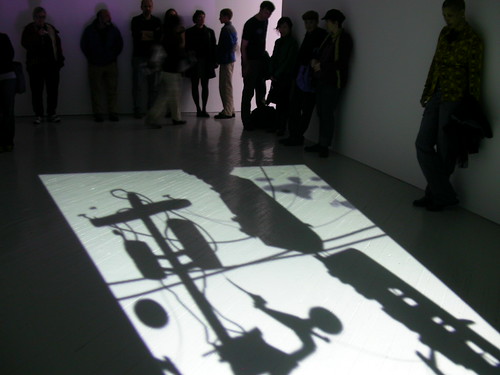
Paul Chan, First Light. The Scholl Collection includes all of Chan’s light pieces. This photo is from a 2006 show at the Fabric Workshop.
Roberta: How many pieces in your collection?
Dennis: Our collection is 500+ works. We have a building called World Class Boxing (which is what it was, a boxing gym).
They have shows, they commission artists…like Mark Bradford and Jim Lambie. “For the last seven years we’ve been working with artists that way.”
He’s very excited about going to meet Zoe Strauss in the afternoon.

Melanie Schiff. Neil Young, Neil Young. 2006 C-Print. 30×40″ Thanks to MWCapacity blog for the reminder that Schiff will be in the upcoming Whitney Biennial.
R: Do you have a background in art?
D: I never went to a museum until I was 25. I grew up in an outdoor society, diving, etc…Debra and I met in Law School. It was alphabetical seating. We worked in an art gallery where we sold art to go over your sofa. We did that to pay for law school. At the end of the month we bought good art with everything we made.
R: What did you begin collecting?
D: We bought prints. The first piece cost $175, a Robert Motherwell. 16-17 years ago we decided to switch. We gave away the print collection. We try to give away 5% of the collection a year.
R: Who do you give to, museums?
D: Yes, the Walker, the Tate…(mentions other museums)
R: So what’s in the collection now?
D: There are 50 videos in the collection. In the early 90s we began to collect contemporary photography–artists who use photography to make art, not photographers. No Walker Evans-type work. All these kids are coming out of college with their digital cameras. We got enamored of the Yale girls. You know who I mean.
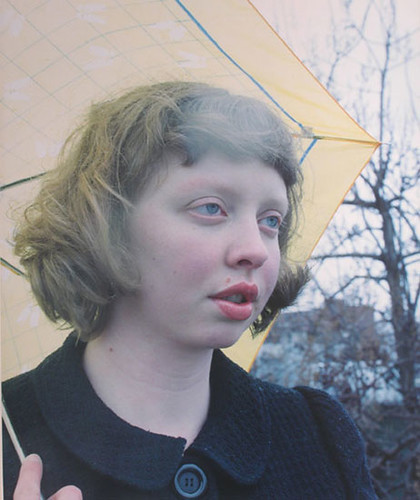
Tanyth Berkeley. Suzanne, from the Series Orchidaceae. C-Print. 20×24″ This piece is in the Moore show.
R: Justine Kurland…students of Gregory Crewdson.
D: We call them Gregory’s girls. It’s also a reference to an Irish soccer movie [Scottish movie, Gregory’s Girl]. Then (after spending years buying the contemporary photography) we went back and bought older works — Acconci, Schneeman…We buy what’s made today but we have to go back and give context.
D: Every year we turn over our home to a curator. We give them a disc (of works in the collection) and clear the house out (and the curator installs the house anew). We started 9 years ago, with Douglas Fogle (curator of the 2008 Carnegie International). We know him, he’s a good friend. This year it was Matthew Higgs and Jeremy Deller (collaborating). Other years Amada Cruz, Matthew Drutt, Dominic Molon…
R: Do you ever get it installed some way you don’t like?
D: As Debra says, we chose all the works…The surprise is the differences people can find. The collection is very conceptually based. The curators are all conceptually trained.
We talk about the art fairs. He thinks Art Basel Miami Beach has been great for the city.
D: Art Basel Miami’s not about Miami. It’s about a party in the sun in December. It’s been great for Miami. Art Basel has done 2 things. It’s let people look at local artists…(and it inspires the local community to come out at other times of the year). It’s like the boat show–people get inspired and go to Art Basel…then they come out for Second Saturday….
D: Art Basel asked if we come to Miami will you open your homes to us? We said you can come and we’ll open our houses. We open our home during ABM. We have 1500 people in 5 days.
R: How did this show at Moore come about?
D: Lorie (Mertes) called and said what are you doing? I said I’ve been working on this show in my mind for years.
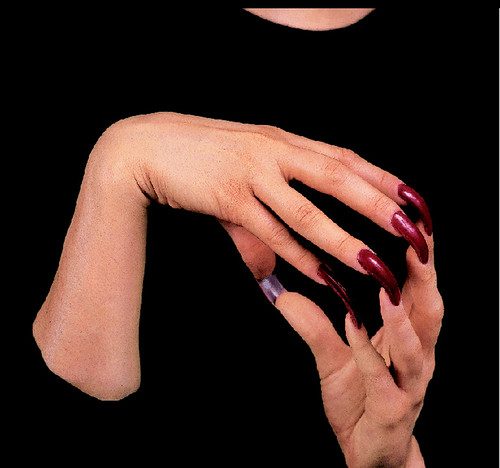
At this point we get up and look around at the show and he gives me a guided tour with color commentary. He’s clearly enamored of the works and the artists who make them although at one point he says “I try not to get too caught up in the relationship with the artist though.”
Trisha Donnelly
D: That’s Trisha’s T. It’s her self portrait. It’s bay and evergreen.
R: How long does it last before you have to bring in new leaves?
D: We refresh it every 3 weeks. We own 7 of her works. We love it….We have a lot of firsts in the show. First self-portraits, etc. Jenny Gage (Yale girl) does self-portraiture. Janine Antoni also (her piece in the Moore show has her fingernails glued together). He tells a story about how Antoni had to sit that way for a long time (10 hours!) because the camera battery died and they couldn’t get a replacement right away..and how uncomfortable that was…but also how very “Janine Antoni” it was (to suffer for your art).
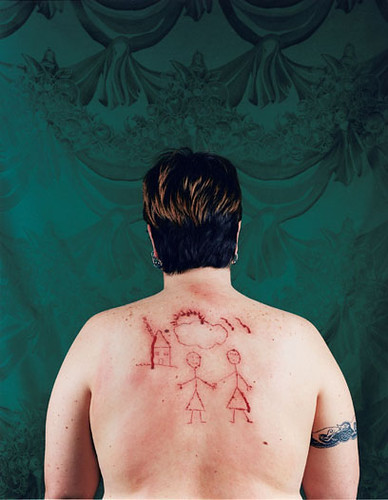
Catherine Opie
Self Portrait, 1993
C-print
40″ x 30″
Catherine Opie
D: This is from her first body of work. It’s a tough work.
Throughout our walk through the gallery Scholl keeps pointing out the howl piece (an audio work) that Trisha Donnelly recorded that plays in the space seemingly coming from nowhere. It’s very subtle but he is listening for it–captivated, delighted.
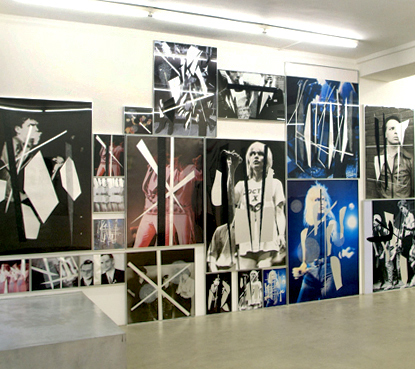
Meredyth Sparks, installation from a show in Paris at Galerie Frank Elbaz. She seems to work with appropriated music images and slices them with her glitter insertions.
Meredyth Sparks
D: She’s a Brooklyn artist. This is a piece we commissioned for the show (not shown). She was a studio assistant for another artist we collect. We said we want a piece by you about women. She used an album cover of Roxy Music‘s 70s album, the one where the cover was banned in the US. The artist has the two album covers side by side (the British and American versions) blown up big and with her signature glitter lines inserted.
Melanie Schiff
D: We fell in love with Melanie Schiff. Suddenly we’re seeing Neil Young all over….including “Jeremy Deller’s What Would Neil Young Do?” (also owned by the Scholls).
Tanyth Berkeley
D: She works with an albino, Grace. She photographs her alot.
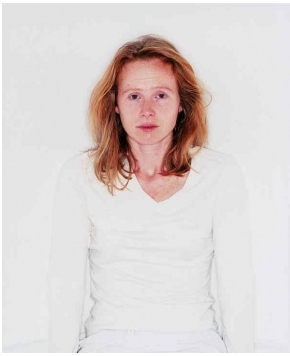
Bettina von Zwehl. Untitled 1, from the series Untitled 1 (Sophy) 1998. C-Print on aluminum. 29 1/2 x 31 1/2″
Bettina von Zwehl
It’s a performance. She askes artists to sleep over and tells them they’ll participate in an art project but doesn’t say what. Then she wakes them up at 3 am and take a photo within 60 seconds. (This reminds me very much of Phil Collins‘s slap photo project.)
Anna Gaskell
She uses models from Des Moines, IA, which is where she is from.
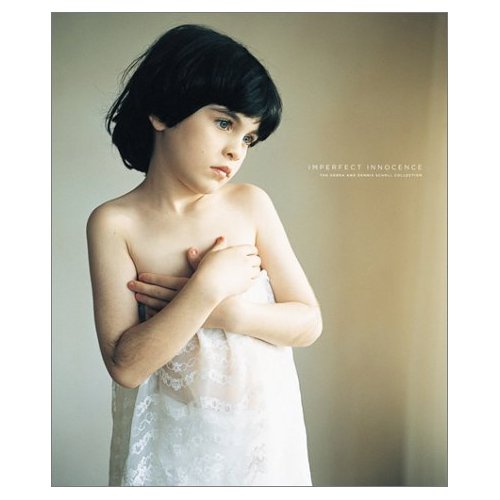
Helen van Meene, Untitled 1998. C-print. 11 3/4 x 11 3/4″. Photo is on the cover of Imperfect Innocence.
Helen Van Meene
Children…she gets the permission of the parents. It’s Amsterdam so it’s not here (people are freer about these things).
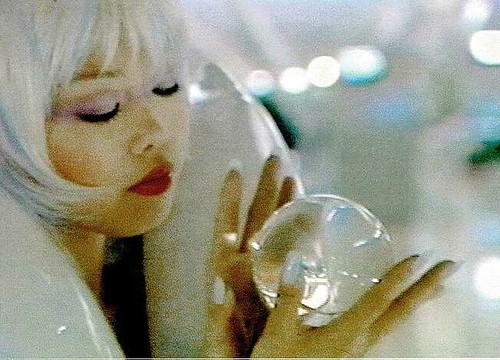
Mariko Mori, Miko no Inori, 1996, video
Mariko Mori
Mariko gets dressed up in a subway station. Nobody looks at her. This is the first video she did. Jeffrey Deitch represents her.
R: I like the pale green wall behind the Mariko Mori video (the video is icy cool with purples and blues dominating; the wall is yummy behind it).
D: I’ve forgotten how beautifully Lorie (Mertes) can install a show….pause…hear Trisha howling? (He’s listening for it and loves what he hears….you can also hear Pipilloti Rist singing from her video in the other room)…Lorie’s done a great job of creating environments you can experience.
He tells me about going to PAFA (he’s never been to Philadelphia before) and loving the little Arthur Dove paintings. “We don’t have a lot of Arthur Dove (pure visual aesthetic art).”
About selecting what to buy:
D: The great thing is you know it when you find it.
Re artists:
D: Artists are different. They think differently than the rest of us.
About the art world:
D: There are maybe 1,000 people in the art world (meaning it’s a very small group of people who are making the big decisions in the art world)… Museums are being marginalized …(but they are the final arbiters). The art world will be settling down now (now with the economic bubble bursting and a recession on the way). Now we can go back (to the auctions)…We haven’t bought at auctions in 10 years but we may (meaning the prices may be coming down).
About students
D: We reach out to institutions. We brought the Baldessari to Tulane because the students hadn’t seen it ( they were not familiar with his work). If we can educate and bring work to people and share their inspiration…Conceptual work isn’t always head on.
About the collection:
D: I like to learn from the collection.While these objects were compiled over 15 years, it’s Debra and my subconscious you see.
About buying together as a couple:
D: In the 80s I did buy a few things myself. I came home with something and Debra was in bed with the flu and I showed her what I bought. She said “I hate that.” And a week later she said “I think we should have a two-vote rule.” So we have a two-vote rule. It’s a 30 year collaborative project. It’s the cornerstone of our relationship.

Scholl (right) and Richard Betts, partners in the new Australian wine venture, Betts and Scholl.
R: What do you do now that you’re retired from the law?
D: Now, we make wine. In Australia. Betts and Scholl. Artists make the labels–Isaac Julian, Raymond Pettibon, Mark Grotjahn. Before that we were developers in South Beach. We did historic restorations. Before that I did venture capital law and Debra did banking law. Now we do venture capital.
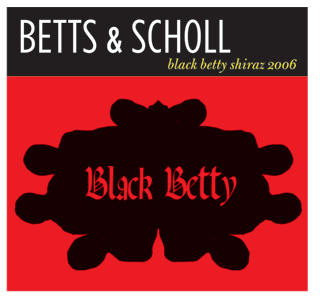
Betts and Scholl wine label by Jim Lambie
R: Do you lecture?
D: What I say is I do all the talking and Debra does all the thinking.
He asks me about the Philly art scene and I mention about all the young people, collectives, anti-market stuff going on.
D: Miami used to be lots of collectives. Now many of the artists have moved up to another level with regular gallery shows.
R: Tell me about the Miami collector’s group you founded?
D: I founded a group for Miami Art Museum . The Collectors Council. You put money in a pot and give the curators an opportunity to select contemporary work for the permanent collection. Miami is not like Philly. There’s not a history of dead guys (giving money–rich donors to the museums…and lots of old art).
About the American artists acquisitions committes at the Tate and the photo acquisitions committee at the Guggenheim
D: I worked with Nancy Spector at the Guggenheim and then Sir Nick (Serota) asked me to do it for the Tate. American photography. We did that for them.”
R: Are you still involved in those committees?
D: Five years is enough for each of them. I run out of ideas. I like the interaction with curators. That kind of public service is great. I can really help.
R: You have a travel budget.
D: I have a better travel budget which lets me see a lot of new work.
R: What do you think of Chinese art–do you collect it?
D: We made a conscious decision to not do that. People need time to interact…Another reason, it’s market driven. Mattering in the market is not the same as mattering in the art world. When my instincts tell me to, I shy away.
R: How about Africa–photographer Malick Sidibe and William Kentridge?
D: Kentridge is an artist I missed. If you decide three shows in you want to collect, it’s too late in today’s market.
R: What are you working on now?
D: We’re trying to do a sculpture show…Simon Starling, Olafur Eliasson and others.
And we’re working on Locust Projects…an experimental alternative space in Miami…
Here’s a book on the Scholl collection, Imperfect Innocence, with essays by Nancy Spector and others. The book is a companion to the 2003 show of the same title at the Baltimore Contemporary Museum. And for more on In Repose see my post, Libby’s post and Andrea’s post.







